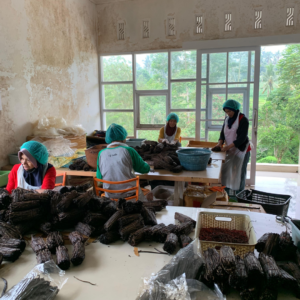Vanilla is among the most valuable spices in the world, widely used in food, beverages, and fragrances. However, vanilla cultivation is a complex and labor-intensive process that demands the right environmental conditions, careful planting methods, and proper post-harvest handling. Successful farming depends on factors such as climate, pollination, and disease management. This guide explores the essential farming practices required to grow high-quality vanilla beans efficiently.
Farming Practices for Successful Vanilla Cultivation

1. Choosing the Right Environment for Vanilla Growth
- Climate Requirements: Vanilla thrives in tropical climates with temperatures ranging from 20°C to 30°C and humidity levels above 80%.
- Soil Conditions: Well-drained, loamy soil rich in organic matter promotes healthy root development.
- Shade and Support System: As a climbing vine, vanilla requires shade from taller trees and support structures for proper growth.
2. Propagation and Planting Techniques
- Using Healthy Cuttings: Vanilla plants are propagated through vine cuttings, which should be at least 30 cm long.
- Planting Method: Cuttings are first kept in a shaded nursery before being transplanted to the main field.
- Spacing and Trellising: Proper spacing (1.5–2 meters apart) and trellising techniques encourage vine growth and improve airflow.
3. Pollination Process in Vanilla Cultivation
- Manual Pollination: Outside of Mexico, where natural pollinators are scarce, vanilla flowers must be pollinated by hand.
- Best Pollination Practices: Pollination should occur early in the morning for maximum success.
- Impact on Yield: Well-executed pollination leads to higher pod production and uniform growth.
4. Pest and Disease Control
- Common Pests: Aphids, mealybugs, and thrips pose significant threats to vanilla vines.
- Major Diseases: Fungal infections, such as root rot and leaf blight, often result from excessive moisture.
- Preventive Strategies: Regular pruning, organic pest control, and proper drainage reduce disease risks.
5. Harvesting and Post-Harvest Processing
- Ideal Harvest Time: Vanilla beans should be harvested when their tips begin to turn yellow, typically 8–9 months after pollination.
- Curing Process: The beans undergo a multi-step process, including blanching, sweating, drying, and conditioning, to develop their characteristic aroma.
- Sorting and Grading: Cured beans are classified based on size, moisture content, and fragrance before reaching the market.

Conclusion:
Vanilla cultivation demands patience, expertise, and meticulous care at every stage, from planting to curing. Farmers who adopt proper techniques can enhance yield, maintain sustainability, and meet the growing global demand for high-quality vanilla. By implementing the best farming practices, vanilla growers can ensure long-term success in this competitive industry.


